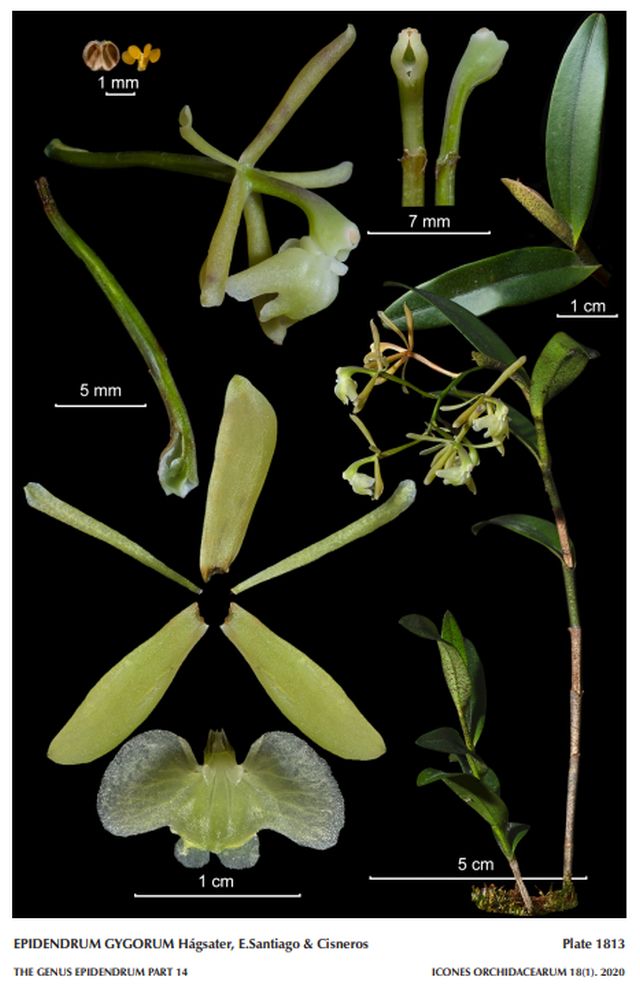

Epidendrum gygorum Hagsater, Santiago and Cisneros 2020 GROUP Gygorum
LCDP by © A. Goicochea & A. Cisneros and Icones Orchidacearum 18(1) plate 1813 2020
Common Name The GYG Epidendrum [Peruvians, In honor of Astrid Domy Gutiérrez Ruiz (1984-) and Antonio Goicochea Rojas (1980-) who have formed the Corporación G Y G in
Moyobamba, San Martín, Perú, to promote the propagation of native orchids, field trips and published a first list of the Orchids of Peru in November
2019 current]
Flower Size .8" [2 cm]
Found in San Martin departmernt of Peru on the eastern slope of the Andes on Andean tepuis in
forests at eelvations around 1700 to 1800 meters as a small sized, cool growing caespitous epiphyte with simple, cane-like, terete, straight, the new stems arising from the base of the previous stem, the basal 2/3 covered by tubular, verrucose, non-foliar sheaths and carrying 4 to 7, distributed along the apical 1/3 of the stem, sub-erect, articulate, unequal, progressively larger, with verrucose, the warts brown, tubular, sheaths, blade oblong-lanceolate, acute, sulcate, dark green above,
somewhat paler and verrucose on the underside, margins entire, spreading leaves that blooms in the spring and fall on a terminal, arising through imbricating, conduplicate, acute,
verrucose spathes which become fibrous and disappear after the first flowering so not present at second flowering, peduncle and rachis ca. .64 to .76" [1.6 to 1.9 cm] long, arcuate, terete, pluri-racemose, producing new racemes from the same peduncle year after year, on second flowering sometimes two
racemes present simultaneously from same peduncle, arching-nutant, laxly, simultaneously 6 flowered inflorescence triangular-linear, acuminate, with much shorter than the ovary floral bracts and carrying resupinate flowers.
NOTE Hagsater states that the characteristic of all the vegetative parts heavily verrucose, including a prominent spathe is quite unusual. Verrucose sheathes are a distinguishing feature of the GROUP Oerstedella in Epidendrum, but they lack the spathe and instead of having a slit rostellum, there is a W shaped
structure at 90° to the axis of the column, separating the stigmatic cavity from the clinandrium, and the pollinarium lacks a viscidium.
"Epidendrum gygorum belongs to the new GROUP Gygorum which is characterized by the sympodial, caespitose habit, the sheaths,
leaves' underside and spathe verrucose, the inflorescence apical, subtended by 1 to 2 prominent acute spathes, spathes only present at first
flowering, pluri-racemose, producing new racemes from the same peduncle years after year, racemes few-flowered, the flowers with 3-lobed lip,
strongly convex, the rostellum slit. The new species it recognized by caespitose habit, vegetative parts including the spathe verrucose, the widely
lanceolate-oblong, acute sepals with strongly revolute margins, the lip deeply 3-lobed, lateral lobes obliquely reniform, somewhat retrorse, midlobe bilobed, and the arched column narrow along the basal 2/3, .28" [7 mm] long. In Epidendrum liguliferum the new stem originates from a sub-apical
internode of the previous stem, flowers are green tinged brown, the disc of the lip and calli white, the is 3-lobed lip, lateral lobes dolabiform,
spreading and opposite, with a pair of square lobes at the apex of the mid-lobe, with very prominent digitiform, divergent calli, and the ovary forms
an elongate vesicle behind the perianth." Hagsater & Cisneros 2020
Synonyms
References W3 Tropicos, Kew Monocot list , IPNI ;
* Icones Orchidacearum 18(1) plate 1813 Hagsater & Santiago 2020 photos fide
--------------------------------------------------------------------------------------------------------------------------


